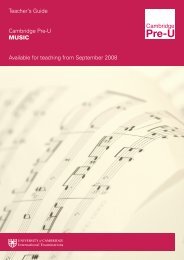Cambridge Pre-U Syllabus - Cambridge International Examinations
Cambridge Pre-U Syllabus - Cambridge International Examinations
Cambridge Pre-U Syllabus - Cambridge International Examinations
You also want an ePaper? Increase the reach of your titles
YUMPU automatically turns print PDFs into web optimized ePapers that Google loves.
40<br />
5.2 Measuring and conserving biodiversity<br />
Content<br />
Biodiversity<br />
Sampling techniques as ecological tools<br />
Principles of conserving biodiversity<br />
The species-area concept<br />
Integrated management strategies<br />
<strong>Cambridge</strong> <strong>Pre</strong>-U Draft<br />
Learning outcomes<br />
Candidates should be able to:<br />
a) explain what is meant by biodiversity with reference to different levels; ecosystem, community, species<br />
and genetic;<br />
b) use, or interpret secondary data from, quantitative and qualitative techniques for measuring biodiversity<br />
and abundance, including diversity indices, percentage cover, species density, direct counts, relative<br />
abundance scales (e.g. ACFORN)<br />
c) explain how to estimate population size using mark-release-recapture and the Lincoln index<br />
d) discuss the importance of conservation and the types of information needed to inform conservation<br />
strategies<br />
e) explain the concept of the keystone species and discuss the consequences of the loss of such species<br />
on biodiversity<br />
f) discuss the importance of conserving biodiversity for social, ethical, medical, economic and<br />
environmental reasons<br />
g) outline the species-area concept in terms of the positive correlation between the species-richness of an<br />
ecosystem and its area.<br />
h) discuss the implications of the species-area concept in conservation strategies including the danger of<br />
habitat fragmentation and the importance of corridors<br />
i) discuss the SLOSS debate [Single Large Or Several Small reserves]<br />
Practical learning outcomes<br />
Candidates should be able to:<br />
i) undertake an ecological survey of at least one ecosystem using appropriate methods, such as open and<br />
grid quadrats, point quadrats, line transect, belt transect and methods for measuring abiotic factors<br />
ii) determine the diversity of an ecosystem by calculating Simpson’s index of diversity or another<br />
appropriate index<br />
iii) determine the population of a small animal using the mark, release recapture method and calculate the<br />
Lincoln index (alternatively this may be modelled)

















